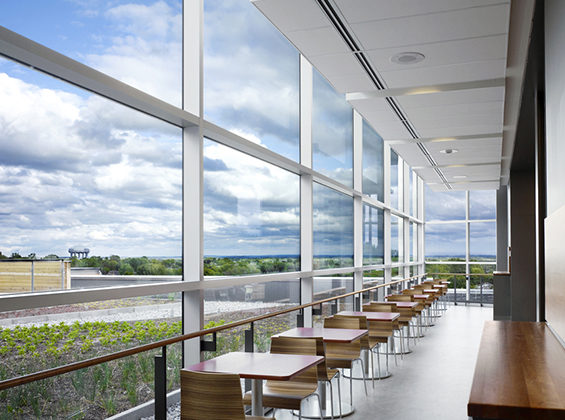
According to a nano-energy expert who spoke in Toronto last week, in the future the glass walls on our buildings could be generating the energy we need to run those buildings, while "e-boxes" would enable us to transmit that power wirelessly...
According to a nano-energy expert who spoke in Toronto last week, in the future the glass walls on our buildings could be generating the energy we need to run those buildings, while “e-boxes” would enable us to transmit that power wirelessly from building to building and beyond.
Justin Hall-Tipping is an “energy-evangelist” who spoke at H.H. Angus and Associates’ first “Ideation” event held November 8 in downtown Toronto. The mechanical-electrical engineering company held the breakfast event for an invited audience of executives in the buildings, property, government, education, finance and energy sectors.
Hall-Tipping is the chief executive office of Nanoholdings, a U.S.-based company of entrepreneurs and scientists who work in partnership with university researchers around the world. They develop new technologies that they believe will help solve our global problems of overconsumption and depletion of resources.
“We’re pushing the earth to its breaking point,” Hall-Tipping warned, pointing out that the 7 billionth person was now being born. He said the earth takes 1.5 years to replenish the resources we use, and global population growth is “unforgiving.”
“I look at finding answers to the world’s biggest problems with the smallest,” said Hall-Tipping.
He held up what he believes is one of those answers — a small, extremely thin almost transparent piece of material no bigger than his palm — which he said could help us to stop “burning up our planet.” He said he would pass the nano-device round the audience for people to look at, except that it cost million to make the first one.
Incorporating carbon nanotubes “100,000 times thinner than a hair” the nano-device could be affixed to a window to convert light into energy. At night it can do the same with infrared light.
Instead of relying on huge central power plants, said Hall-Tipping, in the future we could be using these extremely localized technologies to condition our interiors.
As for storing energy on site, Hall-Tipping suggest the “eBox,” an idea which he said he’d plotted out on a hotel napkin and which went on to be developed by scientists at the University of Dallas and the University of Toronto.
The eBox is a device that can store, manage and transmit electrons. “Now that looks very much like the computer business to me,” said Hall-Tipping. A prototype has been running for over 2 years. The device would be small enough to be stored in a home and would allow you to store power smartly at off-peak hours.
Combining these kinds of “puzzle pieces” opens up all kinds of possibilities, he said. He can see a time when we could beam the energy we generate in our homes and buildings via wireless transmission to other locations where it’s needed. In this brave new world we might not need a conventional grid at all and the energy produced “on the margins” would be available free.
These concepts may seem far-fetched and impossible now, he said, but he reminded the audience of the rapid pace of technological change that took place last century. His own grandfather had watched Louis Bleriot land after being first to fly an airplane over the English Channel in 1909, and just 60 years later we had landed a man on the moon.
Nanotechnology — playing with the building blocks of the universe, building technologies from the bottom up — “will probably save our world,” he said.
